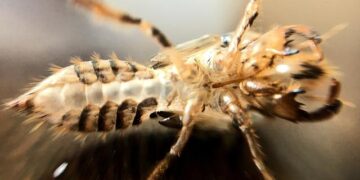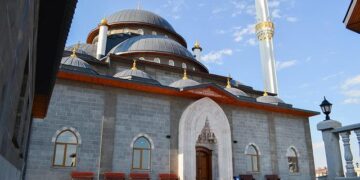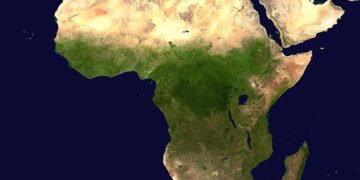Wolves are ecologically vital as keystone species, playing a critical role in maintaining the health and balance of ecosystems. Culturally, wolves hold a unique place in the human imagination, revered and mythologized across various cultures for their intelligence, resilience, and spirit of freedom.From North America to Eurasia, they are deeply embedded in folklore and tradition, often symbolizing strength and guidance. In many Indigenous communities, wolves have a prominent role in traditional culture, often revered as ancestral figures, spiritual guides, and symbols of the untamed natural world.In her new book, “Echo Loba, Loba Echo: Of Wisdom, Wolves, and Women”, Sonja
Swift dives into the multifaceted relationship between humans and wolves. From childhood recollections to ecological roles, and from colonial impacts to modern conservation efforts, her work is an exploration of how wolves mirror our own stories, fears, and hopes.Swift recently spoke with Mongabay Founder and CEO Rhett Ayers Butler about the deep-seated symbolism of the wolf and its significant yet often misunderstood place in our world. She also shared insights on how the conservation sector is evolving.
Wolves, with their widespread distribution from North America to Eurasia, are ecologically vital as keystone species, playing a critical role in maintaining the health and balance of ecosystems by regulating prey populations. Their influence extends to increasing biodiversity and reshaping landscapes, thus fostering more robust and diverse natural environments.
Culturally, wolves hold a unique place in the human imagination, revered and mythologized across various cultures for their intelligence, resilience, and spirit of freedom. In many Indigenous communities, wolves have a prominent role in folklore and spiritual beliefs, often revered as ancestral figures, spiritual guides, and symbols of the untamed natural world.
In her new book, Echo Loba, Loba Echo: Of Wisdom, Wolves, and Women, Sonja Swift delves into wolves and their intricate connections with human society, ecosystems, and cultural narratives.

Bridging ecological insight with a rich tapestry of cultural wisdom, Swift dives into the multifaceted relationship between humans and wolves, a bond that has been both cherished and challenged throughout history. From childhood recollections to ecological roles, and from colonial impacts to modern conservation efforts, her work is a profound exploration of how wolves mirror our own stories, fears, and hopes.
Swift recently spoke with Mongabay about how wolves reflect our existence and the myriad ways they are perceived across cultures. She discussed how Echo Loba, Loba Echo reflects her personal explorations and deep connections with these creatures, and shared observations on the evolving conservation sector’s recognition of Indigenous and Native interactions with the natural world.
 Sonja Swift
Sonja Swift
AN INTERVIEW WITH SONJA SWIFT
Mongabay: You discuss this at length in your book, but for people who haven’t read it yet, what inspired you to write a book that intertwines the stories of wolves with themes of womanhood and ecological awareness?
Sonja Swift: In many ways it was the inter-relationality among themes that compelled me to write this, or otherwise what inspired me to keep at writing it. There are many books about wolves, often from a more biological perspective, but what felt asked of me was to weave together stories that also reflected back upon us as people in relationship with wolves, both through coexistence and through endangering their erasure. Various associations revealed themselves along the way, including those between wolves and women. Having lived my own life in defiance of censoring patriarchal forces, such parallels were easy to notice. And as far as ecological awareness, wolves speak to this in a deep way, as ‘keystone species’ in scientific language and as the ‘one who shows us the way,’ which is the meaning embedded in the Anishinaabe word for wolf, Ma’iingan.
Mongabay: You open the book with the story of your grandmother providing an opportunity to sponsor an animal at the zoo in Palm Springs. Your grandmother’s reaction to your choice seems to epitomize many peoples’ views on wolves. How did her response shape your perceptions?
Sonja Swift: This comes from my memory as a child basically being asked to pick my favorite animal from a desert zoo. I chose the Mexican wolf and then learned that my choice offended my grandmother. I can remember my own response so clearly, how sincerely baffled I was by her disdain for wolves and also how unflinching I was in my own conviction. Reflecting upon it all these years later I see this little story serving as an illustrative and also somewhat typical depiction of people’s innate love and/or confounding hatred of wolves. Here we were talking about wolves in the confinement of a zoo! And a well-meaning Christmas gift of basically paying extra in some form of a donation for a card with a photo of an animal. Yet, wolf. This very projection upon wolves is at the heart of what I sought to examine in my book.
Mongabay: You note that only six people have been killed by wolves in the U.S. over the past 100 years, yet a significant number of wolves are killed every year under the Wildlife Services agency’s “predator management” program. Why do you think there is such a disconnect between fear of wolves and the danger they actually pose to people and livestock?
Sonja Swift: Yes, the recorded deaths are very few and all in unusual circumstances. The point being that wolves don’t seek out people to kill or eat. Akin to orcas, also known as “sea wolves,” who until quite recently were similarly projected upon, associated with supposed wolf-like malevolence, seen as liable to attack human beings at any opportunity. None of which is true, as people now know about these whales, and all of which is a projection wolves are yet to shake.
The roots of misperception in many ways go back to medieval Europe and then traveled to North America by way of colonization. Settlers brought wolf lore with them, and then used it as part of the economic project of colonization – slaughtering the bison herds alongside the wolves, which meant starving the Indigenous Nations and stealing their land.
 Wolf. Credit: Rhett A. Butler
Wolf. Credit: Rhett A. Butler
There is legitimate fear when it comes to rabies, a rabid wolf like a rabid dog is dangerous, but rabies alone doesn’t explain the complicated projections wolves have been laden with. So I suppose I see old patterns of thought, fear and distrust still playing out under the guise of ranchers concerns and the Wildlife Service agency’s brutal agenda, which leads to another theme I explore in the book: how certain thinking can prevail against all evidence and experience contrary, in particular where entrenched beliefs and vested interests are concerned.
Mongabay: The situation for wolves in Idaho seems particularly dire at the moment. Do you see any ways to improve their plight? For example, would raising public awareness of the role wolves play in the health of ecosystems help broaden the constituency for their protection?
Sonja Swift: If only the Nez Perce, Shoshone, Kootenai among other tribes still held onto more of their homelands within the state of Idaho, that would help. And yes, I do think there is plenty of opportunity to expand public awareness, especially starting with children.
Oddly wolf hatred has weird overlays with political narratives, which can get downright bizarre, and which I didn’t even get into much in the book because calling them terrorists and whatnot is just so nonsensical. A more typical narrative is blaming wolves for eating “Our elk,” without any comprehension of their keystone role in managing the herds and keeping the land bountiful for those very herds to prosper. Sadly, there’s also unrestrained kill lust and banal machismo. These various mentalities often shut the door on seeing another way to live alongside wolves and yet it does remain odd to me that people who call home in beautiful open country can be so keen to decimate the very animals who make these places special.
Wolves, and the stories we tell about wolves, show us ourselves. Hence shifting perception starts with examining ourselves – where we come from, where we belong. Wolf hatred is one thing, another issue is romanticization, both of which are projections that ultimately center people. Perhaps a deeper lesson in all of this is about moving away from human exceptionalism.
Mongabay: The section about the etymology of the word for wolf across languages illustrates both how widespread wolves are geographically and what they have come to represent in societies and culture. Accordingly, you refer to the wolf as a metaphor that embodies colliding worldviews and wisdom. Could you delve deeper into what the wolf symbolizes in your book and why this metaphor is significant?
Sonja Swift: The metaphor of wolf, as I understand and present it, has far more to do with people than wolves, and the human propensities toward control, destruction, violence, and greed. For, in this case, I am not referring to wolves directly as the beings they are, but to the ways in which “wolf” has come to mean so many divergent things. And perhaps I am also dreaming about how – if only – people could more widely value a conceptual metaphor, a story, an understanding that honors wolves as harboring wisdom for how to live, which is knowledge that can’t be quantified, contained, bought or sold.
 Wolves in Yellowstone National Park. Photo credit: National Park Service
Wolves in Yellowstone National Park. Photo credit: National Park Service
I could not possibly write about wolves without examining the minds that strive to eradicate them. This leads directly to forces of colonialism, and yet also actually ties into the origins of corporate conservation as an industry guided by dualistic colonial thinking which has tended to view people as separate from nature. Today this involves the world’s largest environmental NGO’s, which have revolving doors with global finance and extractive industries and which remain led by top-down economic agendas, such as fortress conservation and carbon offsets schemes. There is an important distinction here from ‘conservation’ as a common-sense and localized practice, a spiritual practice.
I suppose on a whole this book speaks to colliding worldviews because the enduring fight of Earth ethos versus evangelical industrialization is really a fight over cosmology/worldview, which the metaphor of wolf shows us. And greenwashing has no place here, as it just distracts and distorts real reckoning with how seriously survival is at stake.
Mongabay: Your book focuses a lot on the relationship Indigenous peoples have with wolves. Could you highlight an example that is illustrative of this relationship?
Sonja Swift: The full and direct translation of the Anishinaabe word for wolf, Ma’iingan, means “the one sent here by that all loving spirit to show us the way” and is profoundly illustrative of the relationship Indigenous peoples have with wolves. I learned this word and translation while visiting Winona LaDuke, who wrote the beautiful foreword, and Robert Shimek at the White Earth Ojibwe Nation in Minnesota years ago. It was here I met an understanding of wolf, as longstanding as the Indigenous Nation whose land language articulated it, that finally made sense to me.
 Wolf. Photo credit: Rhett A. Butler
Wolf. Photo credit: Rhett A. Butler
Of course, wolves have deep significance across many cultures – as ancestors, guides, and protectors. For instance, the Ainu of northern Japan have origin stories that speak about the union of a wolf-like canine and a goddess, similarly to Turkic legends about a she-wolf giving birth to half-wolf, half-human cubs, their ancestors. The Lakota emergence story tells of Sungmanitu Tanka, the Wolf, guiding the people home. In Mongolia, wolves are considered the protective spirits of the grasslands, spiritually and also literally, as they are now widely understood to be. As you can see the overlays of meanings and understandings run deep and go back far in intergenerational memory, at least for cultures who never segregated themselves from wolves.
Mongabay: On a related front, there seems to be a shift underway in the conservation sector to put more emphasis on the role Indigenous peoples and local communities play in maintaining health and productive ecosystems. Do you have thoughts on this trend?
Sonja Swift: I think what is well understood is that Indigenous people’s lands hold the majority of the world’s remaining bio-cultural diversity, which in some people’s lexicon still means that deadpan word “resources.” While I agree there is authentic growing awareness generally, and I appreciate Mongabay’s coverage of the myriad ways Indigenous peoples and local communities are skillfully maintaining the health of their own lands and waters on their own terms, what concerns me are the financial agendas of the corporate conservation sector. When big industry and global finance are behind determining conservation policy it falls flat, and when you look at the boards of the world’s largest environmental NGOs the representation is skewed accordingly. So even if Indigenous people are more often acknowledged for their critical roles as land and water protectors on the surface, the agendas of corporate conservation remain centered on an outdated economic playbook that prioritizes so-called protected areas and especially carbon offset markets – not the creative concepts of local and Indigenous communities. So even where Indigenous and/or local partnerships do form with these players, when the guiding agenda remains controlled by the largest, most well-funded, there remains a huge power imbalance that severely restricts imagination. The terms are set. The goal clearly isn’t creativity, rather it’s about maintaining economic and political influence.
 Forest in the Sierra Nevada
Forest in the Sierra Nevada
Protected areas become a particular irony when the original caretakers are shoved aside and oil companies are welcomed in to drill. Carbon markets are delusional, oil is the repository of eons, there is no offsetting something that takes millions of years to make. Yet even with mounting evidence from decades of failures to protect anything but private financial interests (corruption, land grabs, human rights abuses) we now have the International Monetary Fund and affiliated corporate conservationists commodifying whales and elephants as the first living beings to be reduced to carbon credits for sale as an offset. I’ve heard people similarly propose wolves given their own keystone role. It begins with a mentality that objectifies life, and then seeks to commercialize it. I see no wisdom in commodifying life.
Instead of focusing on Indigenous land rights, carbon offset schemes have brought wave upon wave of financial minded entrepreneurs into Indigenous communities pushing jargon-heavy contracts that undermine Indigenous customary rights to protecting their own homelands. This is full-on contrary to conservation as a skillful practice of caretaking one’s home. In the rare instances where communities have agency, the big win is that they are getting paid some money. There are other ways to support local land protection and management efforts than through offsets schemes. Yet hegemonic forces continue to be very recalcitrant about change and letting go of control.
A story I cite in my book is about Aldo Leopold, once a wolfer, who became the nature writer and environmental advocate he is known as the day he met the eyes of a mother wolf dying. I name how he arrived at this knowledge the destructive way, but began to embody a different metaphor than wolf as vermin, in need of subduing, controlling, eliminating. Unfortunately, I see the massive environmental NGO’s and affiliated philanthropies still often guided by metaphorical thinking that situates them as saviors of Nature/wild animals, rather than the other way around, as Indigenous people understand and instruct. Hence wolves as guides. These very shifts in perception change everything.
Mongabay: What do you hope readers will take away from your book?
Sonja Swift: To honor and protect the wolves, which starts with honoring and protecting one’s own wolf-like knowing.

Animals, Biodiversity, Carnivores, Conservation, Endangered Species, Environment, Featured, Forests, Green, Hunting, Indigenous Communities, Indigenous Cultures, Indigenous Peoples, Indigenous Rights, Interviews, Interviews with conservation players, Mammals, Predators, Top Predators, Wildlife, Wolves
Global, United States
Wildlife Services Agency
![]()
PRINT
>>> Read full article>>>
Copyright for syndicated content belongs to the linked Source : MongaBay – https://news.mongabay.com/2023/12/wolves-through-the-ages-a-journey-of-coexistence-conflict-and-conservation/































